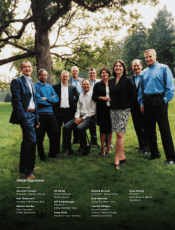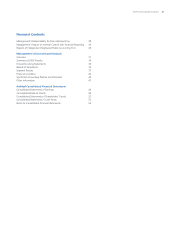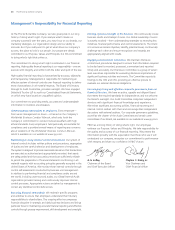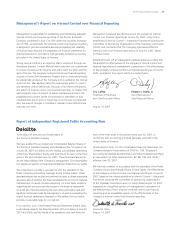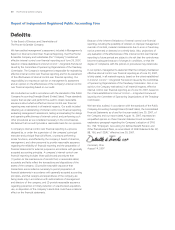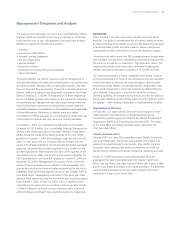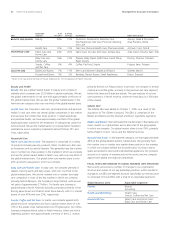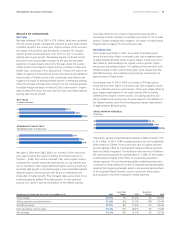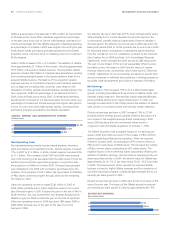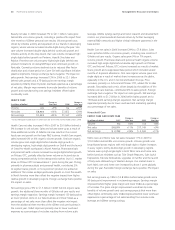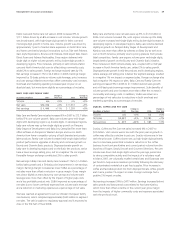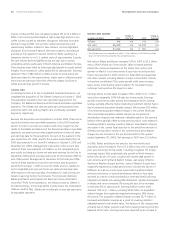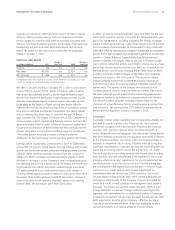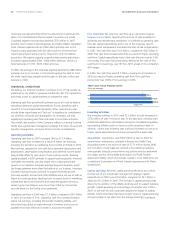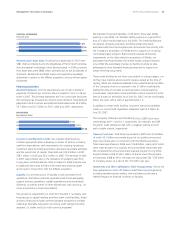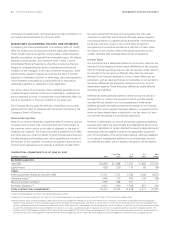Proctor and Gamble 2007 Annual Report Download - page 36
Download and view the complete annual report
Please find page 36 of the 2007 Proctor and Gamble annual report below. You can navigate through the pages in the report by either clicking on the pages listed below, or by using the keyword search tool below to find specific information within the annual report.The Procter & Gamble Company
34 Management’s Discussion and Analysis
º The MDO develops go-to-market plans at the local level, leveraging
their understanding of the local consumers and customers.
The MDO is focused on winning the “rst moment of truth”
—
when a consumer stands in front of the shelf and chooses a product
from among many competitive offerings.
º Global Business Services operates as the “back ofce” for the GBUs
and the MDO, providing cost-effective world-class technology,
processes and standard data tools to better understand the business
and better serve consumers and customers. GBS personnel, or
highly efcient and effective third-party partners, provide these
services.
• Focusing relentlessly to improve costs and generate cash. Each
organization is evaluated on its ability to support the Company’s
nancial goals and increase total shareholder return. This includes
an evaluation of net sales growth, earnings growth, prot margin
expansion and cash productivity. Our organizations are evaluated
on their ability to generate cash, for example, by increasing capacity
utilization and meeting capital spending targets or by reducing
working capital required to run the business.
For the scal year ended June 30, 2007, we delivered our sixth
consecutive year of sales growth and free cash ow productivity at or
above our stated targets.
Net sales increased 12% to $76.5 billion.
º Organic sales, which exclude the impacts of acquisitions,
divestitures and foreign exchange, increased 5%, in line with our
post-Gillette organic sales growth target range of 4% to 6%.
º Every reportable segment delivered year-on-year organic sales
growth.
Diluted net earnings per share increased 15% to $3.04.
º Lower Gillette dilution in 2007 contributed approximately 4% to
EPS growth.
Cash ow from operating activities was $13.4 billion.
º Free cash ow productivity was 101%, ahead of our 90% target.
We discuss expectations regarding future performance, events and
outcomes, such as our business outlook and objectives, in annual and
quarterly reports, press releases and other written and oral communications.
All such statements, except for historical and present factual information,
are “forward-looking statements,” and are based on nancial data
and our business plans available only as of the time the statements
are made, which may become out-of-date or incomplete. We assume
no obligation to update any forward-looking statements as a result of
new information, future events or other factors. Forward-looking
statements are inherently uncertain, and investors must recognize
that events could be signicantly different from our expectations.
Ability to Achieve Business Plans. We are a consumer products
company and rely on continued demand for our brands and products.
To achieve business goals, we must develop and sell products that
appeal to consumers and retail trade customers. Our continued
success is dependent on leading-edge innovation with respect to
both products and operations and on the continued positive
reputations of our brands. This means we must be able to obtain
patents and respond to technological advances and patents granted
to competition. Our success is also dependent on effective sales,
advertising and marketing programs in an increasingly fragmented
media environment. Our ability to innovate and execute in these
areas will determine the extent to which we are able to grow existing
sales and volume protably, especially with respect to the product
categories and geographic markets (including developing markets) in
which we have chosen to focus. There are high levels of competitive
activity in the environments in which we operate. To address these
challenges, we must respond to competitive factors, including pricing,
promotional incentives and trade terms. We must manage each of
these factors, as well as maintain mutually benecial relationships
with our key customers, in order to effectively compete and achieve
our business plans. Since our goals include a growth component tied
to acquisitions, we must manage and integrate key acquisitions, such
as the Gillette and Wella acquisitions, including achieving the cost
and growth synergies in accordance with stated goals.
Cost Pressures. Our costs are subject to uctuations, particularly due
to changes in commodity prices, raw materials, cost of labor, foreign
exchange and interest rates. Therefore, our success is dependent, in
part, on our continued ability to manage these uctuations through
pricing actions, cost savings projects, sourcing decisions and certain
hedging transactions. We also must manage our debt and currency
exposure, especially in volatile countries. We need to maintain key
manufacturing and supply arrangements, including sole supplier and
sole manufacturing plant arrangements. We must implement, achieve
and sustain cost improvement plans, including our outsourcing projects
and those related to general overhead and workforce rationalization.
Global Economic Conditions. Economic changes, terrorist activity
and political unrest may result in business interruption, ination,
deation or decreased demand for our products. Our success will
depend in part on our ability to manage continued global political
and/or economic uncertainty, especially in our signicant geographic
markets, as well as any political or economic disruption due to
terrorist and other hostile activities.
Regulatory Environment. Changes in laws, regulations and the
related interpretations may alter the environment in which we do
business. This includes changes in environmental, competitive and
product-related laws, as well as changes in accounting standards and
taxation requirements. Accordingly, our ability to manage regulatory,
tax and legal matters (including product liability, patent and intellectual
property matters, as well as those related to the integration of Gillette
and its subsidiaries) and to resolve pending matters within current
estimates may impact our results.



